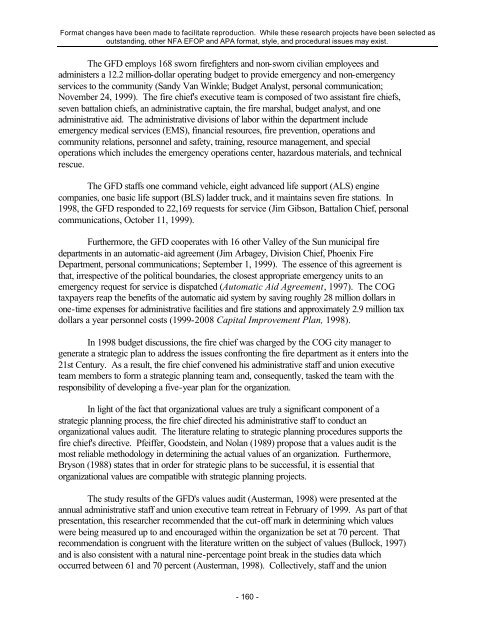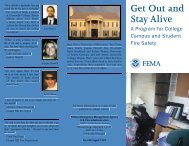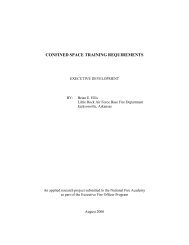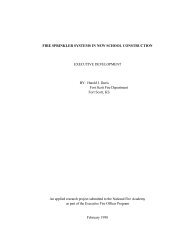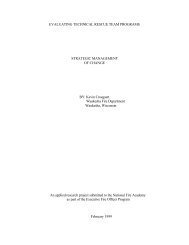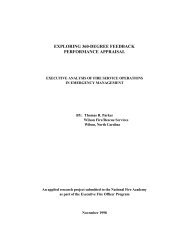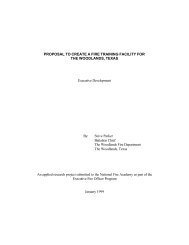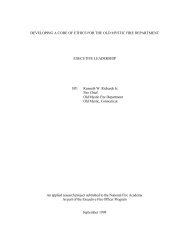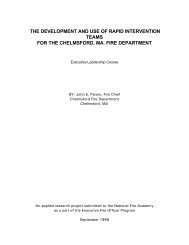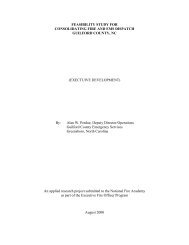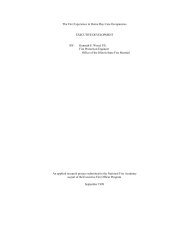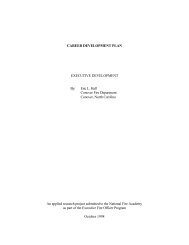Value Statements - US Fire Administration
Value Statements - US Fire Administration
Value Statements - US Fire Administration
Create successful ePaper yourself
Turn your PDF publications into a flip-book with our unique Google optimized e-Paper software.
Format changes have been made to facilitate reproduction. While these research projects have been selected as<br />
outstanding, other NFA EFOP and APA format, style, and procedural issues may exist.<br />
The GFD employs 168 sworn firefighters and non-sworn civilian employees and<br />
administers a 12.2 million-dollar operating budget to provide emergency and non-emergency<br />
services to the community (Sandy Van Winkle; Budget Analyst, personal communication;<br />
November 24, 1999). The fire chief's executive team is composed of two assistant fire chiefs,<br />
seven battalion chiefs, an administrative captain, the fire marshal, budget analyst, and one<br />
administrative aid. The administrative divisions of labor within the department include<br />
emergency medical services (EMS), financial resources, fire prevention, operations and<br />
community relations, personnel and safety, training, resource management, and special<br />
operations which includes the emergency operations center, hazardous materials, and technical<br />
rescue.<br />
The GFD staffs one command vehicle, eight advanced life support (ALS) engine<br />
companies, one basic life support (BLS) ladder truck, and it maintains seven fire stations. In<br />
1998, the GFD responded to 22,169 requests for service (Jim Gibson, Battalion Chief, personal<br />
communications, October 11, 1999).<br />
Furthermore, the GFD cooperates with 16 other Valley of the Sun municipal fire<br />
departments in an automatic-aid agreement (Jim Arbagey, Division Chief, Phoenix <strong>Fire</strong><br />
Department, personal communications; September 1, 1999). The essence of this agreement is<br />
that, irrespective of the political boundaries, the closest appropriate emergency units to an<br />
emergency request for service is dispatched (Automatic Aid Agreement, 1997). The COG<br />
taxpayers reap the benefits of the automatic aid system by saving roughly 28 million dollars in<br />
one-time expenses for administrative facilities and fire stations and approximately 2.9 million tax<br />
dollars a year personnel costs (1999-2008 Capital Improvement Plan, 1998).<br />
In 1998 budget discussions, the fire chief was charged by the COG city manager to<br />
generate a strategic plan to address the issues confronting the fire department as it enters into the<br />
21st Century. As a result, the fire chief convened his administrative staff and union executive<br />
team members to form a strategic planning team and, consequently, tasked the team with the<br />
responsibility of developing a five-year plan for the organization.<br />
In light of the fact that organizational values are truly a significant component of a<br />
strategic planning process, the fire chief directed his administrative staff to conduct an<br />
organizational values audit. The literature relating to strategic planning procedures supports the<br />
fire chief's directive. Pfeiffer, Goodstein, and Nolan (1989) propose that a values audit is the<br />
most reliable methodology in determining the actual values of an organization. Furthermore,<br />
Bryson (1988) states that in order for strategic plans to be successful, it is essential that<br />
organizational values are compatible with strategic planning projects.<br />
The study results of the GFD's values audit (Austerman, 1998) were presented at the<br />
annual administrative staff and union executive team retreat in February of 1999. As part of that<br />
presentation, this researcher recommended that the cut-off mark in determining which values<br />
were being measured up to and encouraged within the organization be set at 70 percent. That<br />
recommendation is congruent with the literature written on the subject of values (Bullock, 1997)<br />
and is also consistent with a natural nine-percentage point break in the studies data which<br />
occurred between 61 and 70 percent (Austerman, 1998). Collectively, staff and the union<br />
- 160 -


